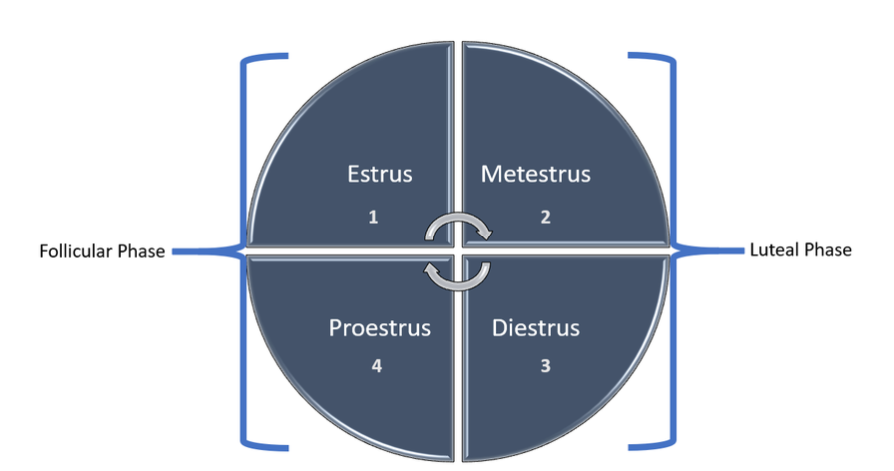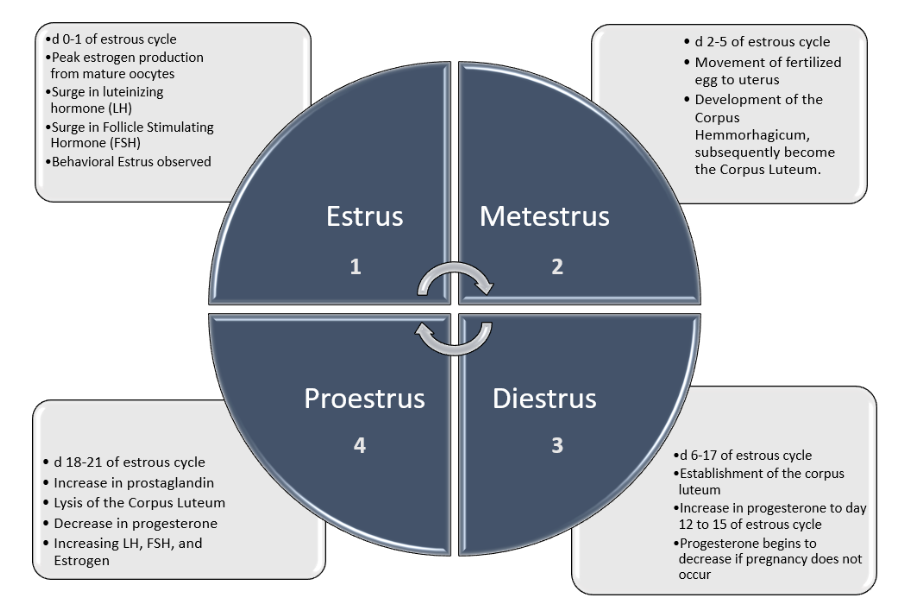



Reproduction in Swine - Understanding the estrous cycle for herd management
Understanding timing of estrous cycle is essential to improving reproductive success of your sowsThe estrous cycle is the dynamic hormonal cycle that controls reproduction in female mammals in relation to the release of eggs (oocytes) and preparation of the uterus for fertilized embryos.
Or to put it shortly, the estrous cycle makes reproduction possible!
While a successful pig operation depends on getting pigs to market, if the breeding herd does not reproduce adequately, then there are fewer pigs available to market from the beginning. Maximizing reproductive performance of your herd may require some trouble shooting if you are struggling to get enough sows or gilts pregnant. There are a multitude of reasons why this might happen, however having a basic understanding of what is happening during the estrous cycle can aid you in determining the best time to breed your sows, and how to apply synchronization programs if the need arises. Here, we will review the stages of the estrous cycle and highlight how those changes can influence reproduction in your sows.
The timeline
In swine, the estrous cycle normally takes 18-21 days to complete, starting with observation of behavioral estrus and ending with the next observation of behavioral estrus. During this cycle, specific hormone levels will increase and decrease to facilitate cellular growth, organ development, and communicate timing of developmental events. These hormonal changes control progression of the estrous cycle through the 4 stages of the estrous cycle.

Follicular phase
Increasing estrogen secretion as the oocyte and follicle mature towards ovulation (release of the egg).
Luteal phase
Increasing progesterone from development of corpus luteum (commonly referred to as the 'yellow body'). Phase of physiological changes surrounding the determination of pregnancy.
Within each of these phases, there are stages identified by the specific hormone changes within the phase of oocyte and follicle morphology
Follicular Phase
Proestrus (d 17 to 21) stage of follicular phase where estrogen and follicle stimulating hormone (FSH) are secreted increasing in preparation for estrus. Small pulses of luteinizing hormone (LH) also begin to be released.
Estrus (d 0 to 1) stage of follicular phase where oocyte has reached maturity. Estrogen, FSH, and LH secretion peaks, causing the follicle to rupture and ovulation to occur. Ovulation typically occurs within 24 - 48 hours of peak estrogen release.
Luteal Phase
Metestrus (d 2 to 4) estrogen, LH, and FSH have all declined and the female is no longer sexually receptive to the boar. The ovarian follicles, which released oocytes during ovulation, begin the process of luteinization to become the corpus hemmorhagicum, and then the corpus luteum. With the formation of the corpus luteum (CL, or 'yellow body') progesterone secretion begins.
Diestrus (d 5 to 18) is the longest stage of the estrous cycle because recognition of pregnancy happens during this phase. During this stage, progesterone continues to increase around day 12 of gestation. At this time, the presence of viable embryos will enable pregnancy to persist. If no viable oocytes are detected by day 15 of gestation, prostaglandin F2 alpha (PGF2α) will act upon the CL, causing it to regress and reduce secretion of progesterone.

Tracking the estrous cycle is best performed using a calendar. Much like the example below, after behavioral estrus has been observed, you can use the calendar to estimate timing of hormonal changes as they relate to the estrous cycle. Based on standing heat, it is common for producers to breed sows at 12 hour intervals, starting 12 hours after the first observed standing heat. Then repeat at 24 hours, and sometimes 36 hours after the first observed standing heat.
Awareness of the first expression of standing heat and knowing the duration of the estrous cycle is most important when ordering semen for mating, considering the application of estrous synchronization protocols or trouble-shooting breeding problems within your herd. Applying this basic knowledge on physiology of the sow will enable you to better utilize tools available for improving reproductive performance of your sow herd.

Headline image courtesy of A.K. Butters-Johnson, Iowa State University








